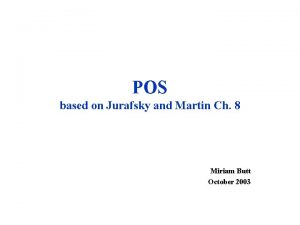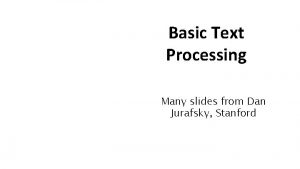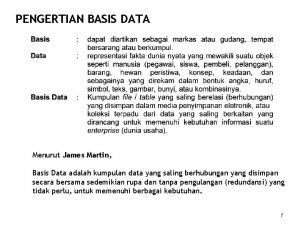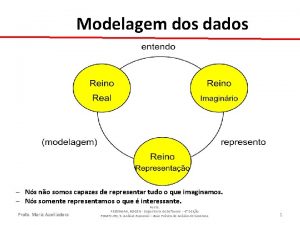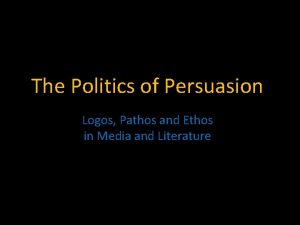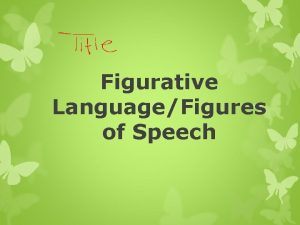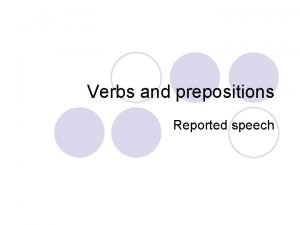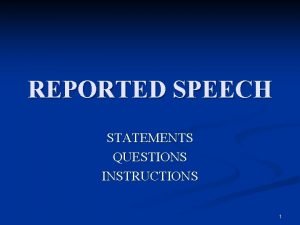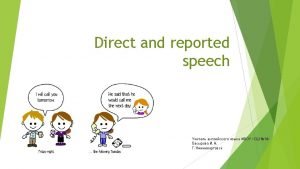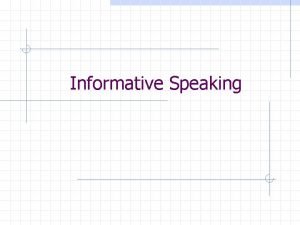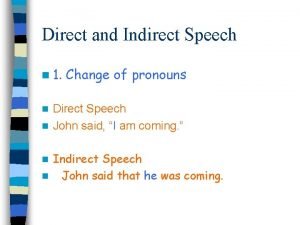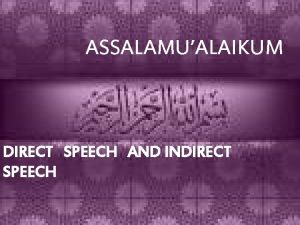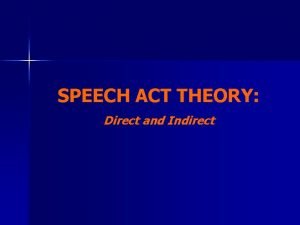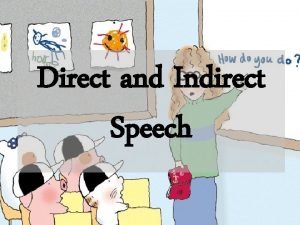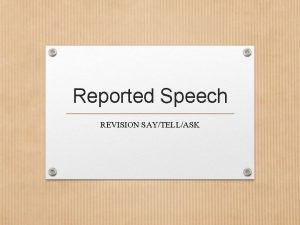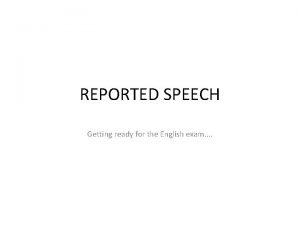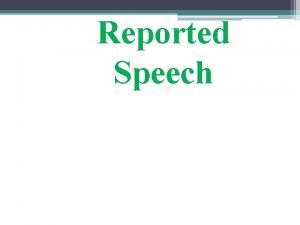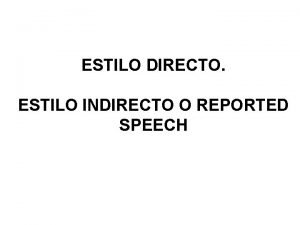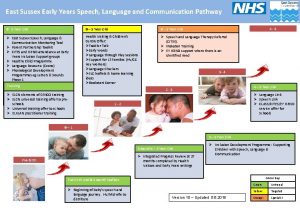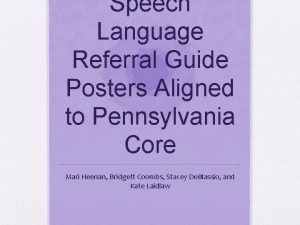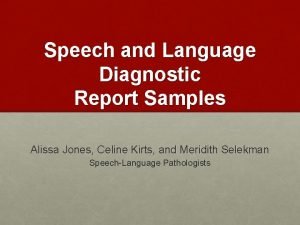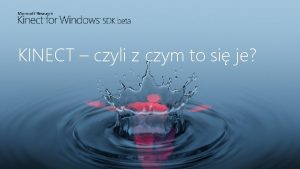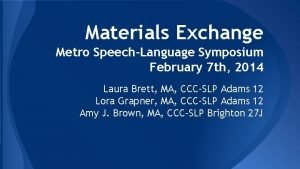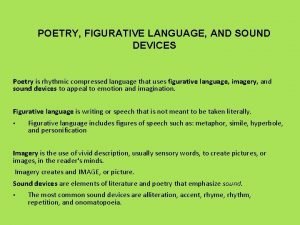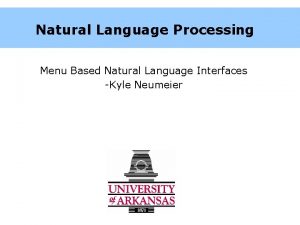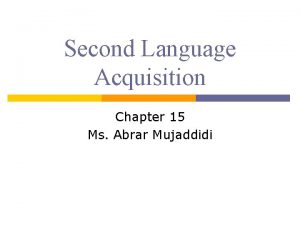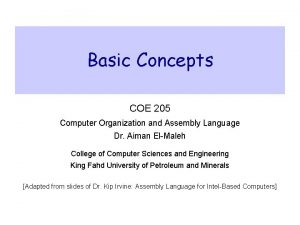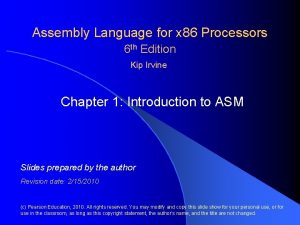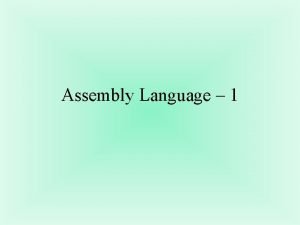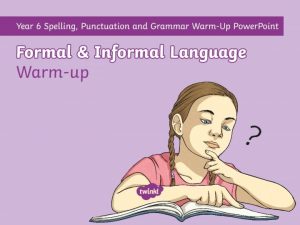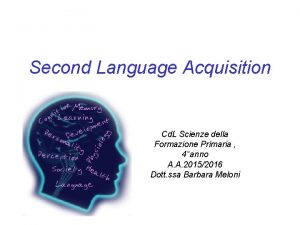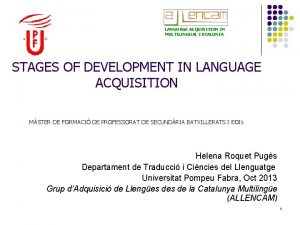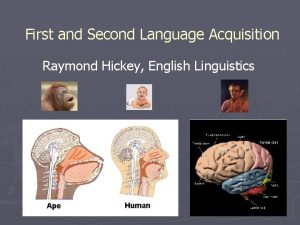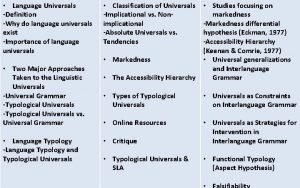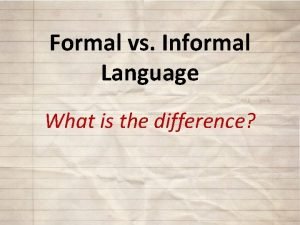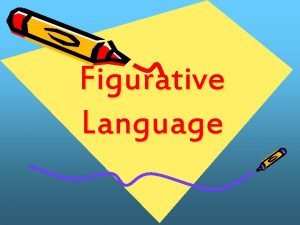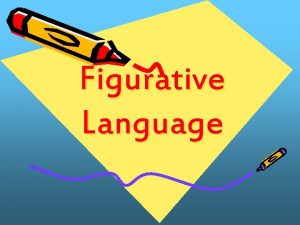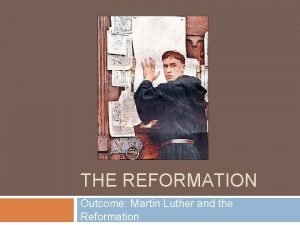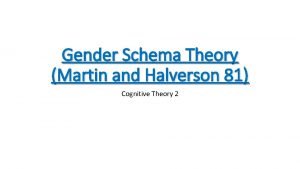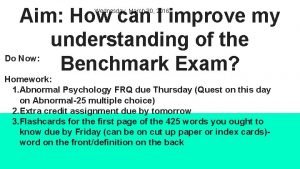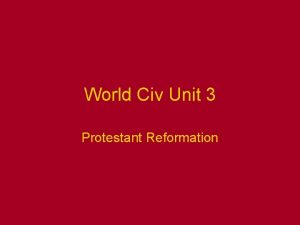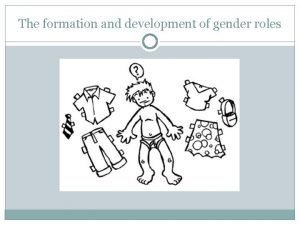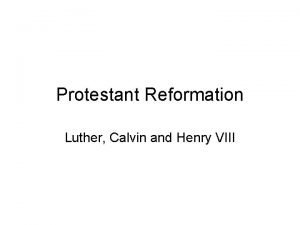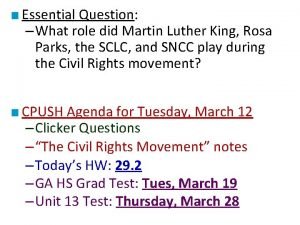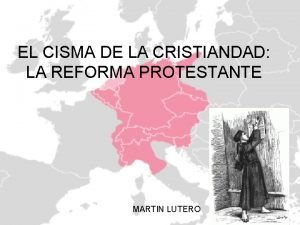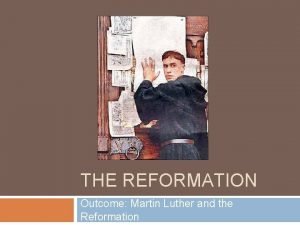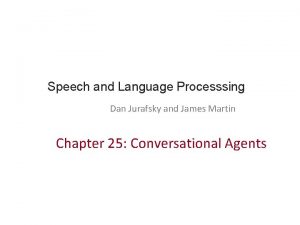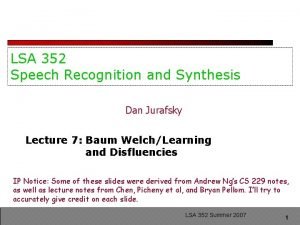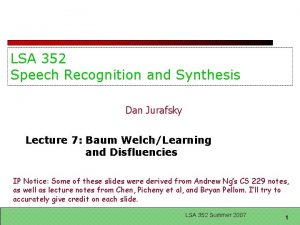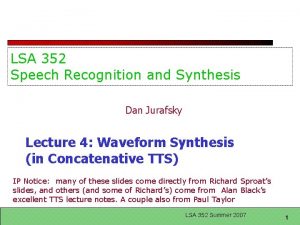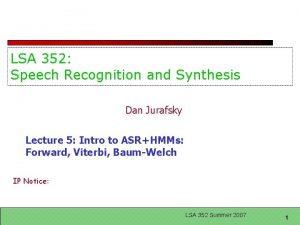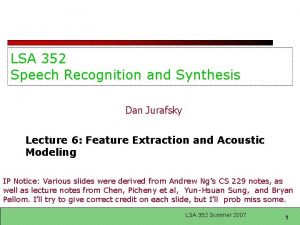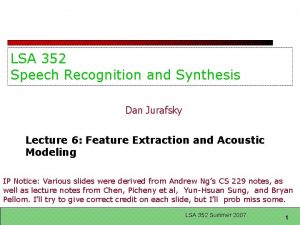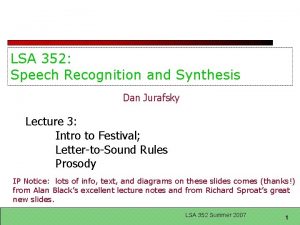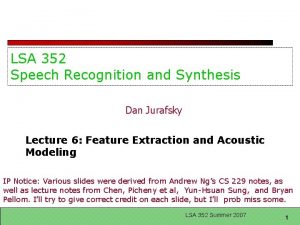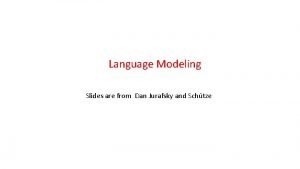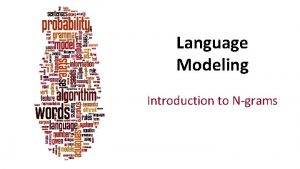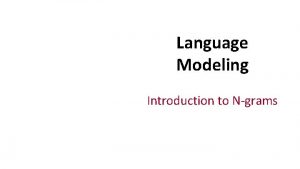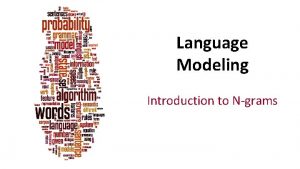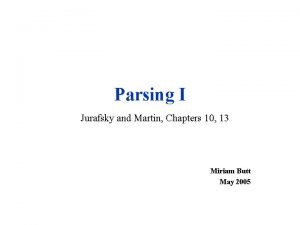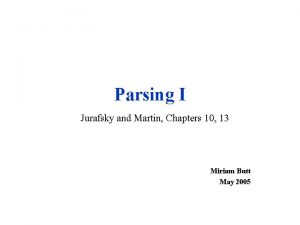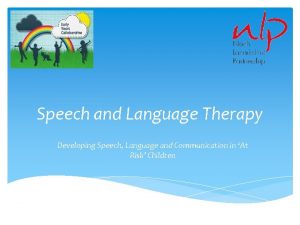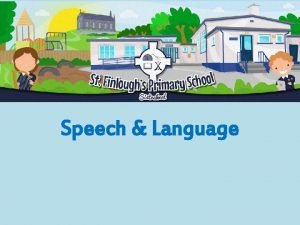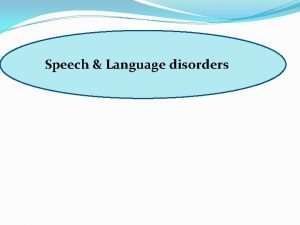Dan Jurafsky and James Martin Speech and Language




































































- Slides: 68

Dan Jurafsky and James Martin Speech and Language Processing Chapter 6: Vector Semantics

What do words mean? First thought: look in a dictionary http: //www. oed. com/

Words, Lemmas, Senses, Definitions lemma sense definition

Lemma pepper Sense 1: spice from pepper plant Sense 2: the pepper plant itself Sense 3: another similar plant (Jamaican pepper) Sense 4: another plant with peppercorns (California pepper) Sense 5: capsicum (i. e. chili, paprika, bell pepper, etc)

A sense or “concept” is the meaning component of a word

There are relations between senses

Relation: Synonymity Synonyms have the same meaning in some or all contexts. ◦ filbert / hazelnut ◦ couch / sofa ◦ big / large ◦ automobile / car ◦ vomit / throw up ◦ Water / H 20

Relation: Synonymity Note that there are probably no examples of perfect synonymy. ◦ Even if many aspects of meaning are identical ◦ Still may not preserve the acceptability based on notions of politeness, slang, register, genre, etc. The Linguistic Principle of Contrast: ◦ Difference in form -> difference in meaning

Relation: Synonymity? Water/H 20 Big/large Brave/courageous

Relation: Antonymy Senses that are opposites with respect to one feature of meaning Otherwise, they are very similar! dark/light hot/cold short/long up/down fast/slow rise/fall in/out More formally: antonyms can ◦ define a binary opposition or be at opposite ends of a scale ◦ long/short, fast/slow ◦ Be reversives: ◦ rise/fall, up/down

Relation: Similarity Words with similar meanings. Not synonyms, but sharing some element of meaning car, bicycle cow, horse

Ask humans how similar 2 words are word 1 word 2 similarity vanish behave belief muscle modest hole disappear obey impression bone flexible agreement 9. 8 7. 3 5. 95 3. 65 0. 98 0. 3 Sim. Lex-999 dataset (Hill et al. , 2015)

Relation: Word relatedness Also called "word association" Words be related in any way, perhaps via a semantic frame or field ◦ car, bicycle: similar ◦ car, gasoline: related, not similar

Semantic field Words that ◦ cover a particular semantic domain ◦ bear structured relations with each other. hospitals surgeon, scalpel, nurse, anaesthetic, hospital restaurants waiter, menu, plate, food, menu, chef), houses door, roof, kitchen, family, bed

Relation: Superordinate/ subordinate One sense is a subordinate of another if the first sense is more specific, denoting a subclass of the other ◦ car is a subordinate of vehicle ◦ mango is a subordinate of fruit Conversely superordinate ◦ vehicle is a superordinate of car ◦ fruit is a subodinate of mango Superordinate vehicle fruit furniture Subordinate car mango chair

These levels are not symmetric One level of category is distinguished from the others The "basic level"

Name these items

Superordinate Basic chair Subordinate office chair piano chair rocking chair furniture lamp torchiere desk lamp table end table coffee table

Cluster of Interactional Properties Basic level things are “human-sized” Consider chairs ◦ We know how to interact with a chair (sitting) ◦ Not so clear for superordinate categories like furniture ◦ “Imagine a furniture without thinking of a bed/table/chair/specific basic-level category”

The basic level Is the level of distinctive actions Is the level which is learned earliest and at which things are first named It is the level at which names are shortest and used most frequently

Connotation Words have affective meanings positive connotations (happy) negative connotations (sad) positive evaluation (great, love) negative evaluation (terrible, hate).

So far Concepts or word senses ◦ Have a complex many-to-many association with words (homonymy, multiple senses) Have relations with each other ◦ Synonymy ◦ Antonymy ◦ Similarity ◦ Relatedness ◦ Superordinate/subordinate ◦ Connotation

But how to define a concept?

Classical (“Aristotelian”) Theory of Concepts The meaning of a word: a concept defined by necessary and sufficient conditions A necessary condition for being an X is a condition C that X must satisfy in order for it to be an X. ◦ If not C, then not X ◦ ”Having four sides” is necessary to be a square. A sufficient condition for being an X is condition such that if something satisfies condition C, then it must be an X. ◦ If and only if C, then X ◦ The following necessary conditions, jointly, are sufficient to be a square ◦ x has (exactly) four sides ◦ each of x's sides is straight ◦ x is a closed figure Example from ◦ x lies in a plane Norman ◦ each of x's sides is equal in length to each of the others Swartz, ◦ each of x's interior angles is equal to the others (right angles) SFU ◦ the sides of x are joined at their ends

Problem 1: The features are complex and may be context-dependent William Labov. 1975 What are these? Cup or bowl?

The category depends on complex features of the object (diameter, etc)

The category depends on the context! (If there is food in it, it’s a bowl)

Labov’s definition of cup

Ludwig Wittgenstein (18891951) Philosopher of language In his late years, a proponent of studying “ordinary language”

Wittgenstein (1945) Philosophical Investigations. Paragraphs 66, 67

What is a game?

Wittgenstein’s thought experiment on "What is a game”: PI #66: ”Don’t say “there must be something common, or they would not be called `games’”—but look and see whethere is anything common to all” Is it amusing? Is there competition? Is there long-term strategy? Is skill required? Must luck play a role? Are there cards? Is there a ball?

Family Resemblance Game 1 ABC Game 2 BCD Game 3 ACD Game 4 ABD “each item has at least one, and probably several, elements in common with one or more items, but no, or few, elements are common to all items” Rosch and Mervis

How about a radically different approach?

Ludwig Wittgenstein PI #43: "The meaning of a word is its use in the language"

Let's define words by their usages In particular, words are defined by their environments (the words around them) Zellig Harris (1954): If A and B have almost identical environments we say that they are synonyms.

What does ongchoi mean? Suppose you see these sentences: • Ong choi is delicious sautéed with garlic. • Ong choi is superb over rice • Ong choi leaves with salty sauces And you've also seen these: • …spinach sautéed with garlic over rice • Chard stems and leaves are delicious • Collard greens and other salty leafy greens Conclusion: ◦ Ongchoi is a leafy green like spinach, chard, or collard greens

Ong choi: Ipomoea aquatica "Water Spinach" Yamaguchi, Wikimedia Commons, public domain

We'll build a new model of meaning focusing on similarity Each word = a vector ◦ Not just "word" or word 45. Similar words are "nearby in space"

We define a word as a vector Called an "embedding" because it's embedded into a space The standard way to represent meaning in NLP Fine-grained model of meaning for similarity ◦ NLP tasks like sentiment analysis ◦ With words, requires same word to be in training and test ◦ With embeddings: ok if similar words occurred!!! ◦ Question answering, conversational agents, etc

We'll introduce 2 kinds of embeddings Tf-idf ◦ A common baseline model ◦ Sparse vectors ◦ Words are represented by a simple function of the counts of nearby words Word 2 vec ◦ Dense vectors ◦ Representation is created by training a classifier to distinguish nearby and far-away words

Review: words, vectors, and co -occurrence matrices

Term-document matrix Each document is represented by a vector of words

Visualizing document vectors

Vectors are the basis of information retrieval Vectors are similar for the two comedies Different than the history Comedies have more fools and wit and fewer battles.

Words can be vectors too battle is "the kind of word that occurs in Julius Caesar and Henry V" fool is "the kind of word that occurs in comedies, especially Twelfth Night"

More common: word-word matrix (or "term-context matrix") Two words are similar in meaning if their context vectors are similar


Reminders from linear algebra vector length

Cosine for computing similarity vi is the count for word v in context i wi is the count for word w in context i. Cos(v, w) is the cosine similarity of v and w Sec. 6. 3

Cosine as a similarity metric -1: vectors point in opposite directions +1: vectors point in same directions 0: vectors are orthogonal Frequency is non-negative, so cosine range 0 -1 51

Which pair of words is more similar? cosine(apricot, information) = cosine(digital, information) = cosine(apricot, digital) = 52 large data computer apricot 1 0 0 digital 0 1 2 information 1 6 1

Visualizing cosines (well, angles)

But raw frequency is a bad representation Frequency is clearly useful; if sugar appears a lot near apricot, that's useful information. But overly frequent words like the, it, or they are not very informative about the context Need a function that resolves this frequency paradox!

tf-idf: combine two factors tf: term frequency count (usually log-transformed): Idf: inverse document frequency: tf- Words like "the" or "good" have very low idf Total # of docs in collection # of docs that have word i tf-idf value for word t in document d:

Summary: tf-idf Compare two words using tf-idf cosine to see if they are similar Compare two documents ◦ Take the centroid of vectors of all the words in the document ◦ Centroid document vector is:

An alternative to tf-idf Ask whether a context word is particularly informative about the target word. ◦ Positive Pointwise Mutual Information (PPMI) 57

Pointwise Mutual Information

Positive Pointwise Mutual Information

Computing PPMI on a term-context matrix Matrix F with W rows (words) and C columns (contexts) fij is # of times wi occurs in context cj 60

p(w=information, c=data) = 6/19 =. 32 p(w=information) = 11/19 =. 58 p(c=data) = 7/19 =. 37 61

pmi(information, data) = log 2 ( . 32 / (. 37*. 58) ) =. 58 (. 57 using full precision) 62

Weighting PMI is biased toward infrequent events ◦ Very rare words have very high PMI values Two solutions: ◦ Give rare words slightly higher probabilities ◦ Use add-one smoothing (which has a similar effect) 63

Weighting PMI: Giving rare context words slightly higher probability 64

Use Laplace (add-1) smoothing 65

66

PPMI versus add-2 smoothed PPMI 67

Summary for Part I • Survey of Lexical Semantics • Idea of Embeddings: Represent a word as a function of its distribution with other words • Tf-idf • Cosines • PPMI • Next lecture: sparse embeddings, word 2 vec
 Jurafsky martin
Jurafsky martin Jurafsky nlp
Jurafsky nlp Dan jurafsky nlp slides
Dan jurafsky nlp slides James russell odom
James russell odom James russell odom and james clayton lawson
James russell odom and james clayton lawson Erd james martin
Erd james martin Notação james martin
Notação james martin An appeal to logos is an appeal to ____.
An appeal to logos is an appeal to ____. Personification definition figure of speech
Personification definition figure of speech Match the verbs with the prepositions
Match the verbs with the prepositions Pure speech vs symbolic speech
Pure speech vs symbolic speech Ann says i'm tired
Ann says i'm tired Direct and reported speech examples
Direct and reported speech examples Direct indirect speech exercises
Direct indirect speech exercises Reported speech
Reported speech Quoted speech to reported speech
Quoted speech to reported speech Gwendolyn brooks: “speech to the young,”
Gwendolyn brooks: “speech to the young,” Persuasive vs informative speech
Persuasive vs informative speech Direct and indirect speech wh-questions examples
Direct and indirect speech wh-questions examples Changing direct to reported speech
Changing direct to reported speech Speech to the young analysis
Speech to the young analysis Sentence type of speech act
Sentence type of speech act Reported speech
Reported speech Changing direct to indirect speech examples
Changing direct to indirect speech examples Persuasive speech vs informative speech
Persuasive speech vs informative speech Before in indirect speech
Before in indirect speech Direct speech into reported speech
Direct speech into reported speech Philip said i was playing football in reported speech
Philip said i was playing football in reported speech Andrew clean the blue bike
Andrew clean the blue bike Preguntas estilo indirecto
Preguntas estilo indirecto Cites east sussex
Cites east sussex Accommodations for speech and language impairment
Accommodations for speech and language impairment Speech and language posters
Speech and language posters Diagnostic report sample
Diagnostic report sample Kinect for windows speech recognition language pack
Kinect for windows speech recognition language pack Metro speech language symposium
Metro speech language symposium Nor language
Nor language Sound devices in poetry definition
Sound devices in poetry definition Speech/natural language interface
Speech/natural language interface Gillian hazell
Gillian hazell -54
-54 Difference between second language and foreign language
Difference between second language and foreign language Difference between standard language and home language
Difference between standard language and home language Assembly vs high level language
Assembly vs high level language Difference between assembly language and machine language
Difference between assembly language and machine language Language
Language Formal and informal language definition
Formal and informal language definition Scienze della formazione
Scienze della formazione Difference of first language and second language
Difference of first language and second language Difference of first language and second language
Difference of first language and second language Language universals meaning
Language universals meaning Characteristics of formal style
Characteristics of formal style Seven types of figurative language
Seven types of figurative language Features of human language
Features of human language Literal vs figurative examples
Literal vs figurative examples Caitlin and martin ganda
Caitlin and martin ganda The reformation outcome martin luther and the reformation
The reformation outcome martin luther and the reformation Martin and halverson
Martin and halverson Chuck recalls the day last summer
Chuck recalls the day last summer Martin and hannah weaver
Martin and hannah weaver Karol wojtyla intersubjectivity
Karol wojtyla intersubjectivity Protestant beliefs
Protestant beliefs Martin hoffman empathy theory health and social care
Martin hoffman empathy theory health and social care David reimer
David reimer Luther calvin and henry viii
Luther calvin and henry viii Representantes de la reforma protestante
Representantes de la reforma protestante Mlk vs malcolm x venn diagram
Mlk vs malcolm x venn diagram Celibato obligatorio
Celibato obligatorio The reformation outcome martin luther and the reformation
The reformation outcome martin luther and the reformation
